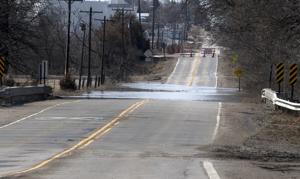
Local government reporter {{description}} Email notifications are only sent once a day, and only if there are new matching items. There was a time when Lancaster County Engineer Pam Dingman and the county commissioners clashed over her requests to update the fleet of heavy equipment. Not anymore.
That changed after the spring of 2019, when flooding washed out 75% of the county’s gravel roads and many of the county's 23 old dump trucks couldn’t withstand the rigors required to get soil back on those roads — and they broke down. Lancaster County is working to replace its older dump trucks. “We were down to five trucks, which was my worst nightmare,” she said.

“The goal since then has been to stabilize the fleet in order to have a fleet that’s more resilient.” To do that, the county has been buying more modern dump trucks with a plan to replace them every 10 years, rather than every 20. That means they’ll break down less when there’s a disaster like the floods in 2019.
Five years ago in March, massive flooding caused an estimated $3.4 billion in damage, breaching 41 levees across the state, flooding communities, stranding residents and threatening critical infrastructure including Lincoln’s water supply. In Lancaster County, 825 miles of gravel road washed away, 42 bridges were closed and dozens of pipes were washed out, Dingman said.
“If you don’t have a truck to get gravel back to stabilize it you’re in a bad place," she said. To avoid that happening again, the county has been upgrading its fleet and last week, the County Board approved the purchase of three dump trucks at a little more than $250,000 apiece, an amended purchase order for four dump trucks to reflect price increases. That amended purchase order is from one last year, where the county ordered the four trucks, but manufacturers are so slow they still don’t have them — and now are being told they likely won’t be delivered until the fall of 2025, Dingman said.
Lancaster County has ordered these more modern dump trucks with a plan to replace them every 10 years, rather than every 20. That means they’ll break down less when there’s a disaster like the floods in 2019. Since 2019, the county has been ordering two to four trucks a year, and after the seven now in the hopper arrive, they’ll have two more to go.
The new dump trucks have other advantages: how much material is released can be controlled remotely, they spread liquid (like brine or deicers) and material is released from conveyors on the bottom so there's less gravel and sand that flies off the road. Those new trucks mean the county uses substantially less material, Dingman said. They’ve been on a similar trajectory with motor graders, she said, and one order was delayed during the pandemic because the crew on the ship (coming from Brazil) had COVID and they couldn’t cross the Panama Canal until they were all COVID-free.
So there have been lots of challenges. "It's a journey. It's an ant and a rubber tree plant.
We're trying to chip away at it a little at a time." The 2019 flooding was caused by a perfect storm of weather conditions; bitter cold, heavy snow and freezing soils followed by a rapid warm-up and a bomb cyclone. That was an unusual storm, but climate change means more severe storms are likely.
Dingman, who experienced the 2015 floods as well, said figuring out how much to put in an emergency fund to plan for such emergencies is hard, though. “I don’t know what reasonable is anymore when you’ve experienced a 4-inch rain on top of 54 inches of snow,” she said. “Those are things we don’t forecast for — but we do now.
” On the topic of roads, Lancaster County just got a $320,000 federal grant made possible through the bipartisan infrastructure bill and a program called Safe Streets and Roads for All. The grant will allow the county to do further planning, which it began with an earlier grant from the Federal Highway Administration, to come up with ways to make roads safer, said County Engineer Pam Dingman. The earlier grant identified concerns around speeding, lack of seatbelt use and driving under the influence, she said.
This grant will allow county officials to figure out what they could do to make roads safer, and it will put them in a position to apply for grants to make those changes. Changes that can make roads safer range from signs and driver education to roundabouts and rumble strips on the side of a road. This year’s “National Preparedness Month” — a reminder to be prepared for weather emergencies — focuses on preparing Asian Americans, Native Hawaiians and Pacific Islanders.
The local take on that is to focus on the immigrant and refugee populations new to the community, who also may be new to the tornadoes and floods and weird straight-line winds and thunderstorms in Nebraska. As usual, the Lincoln-Lancaster County Emergency Management office works with Lincoln Public Schools to implement emergency plans and is offering storm spotter training sessions and is working to improve early warning systems. But the focus on folks new to Lincoln — and our country — seems like a good one.
Download the new Journal Star News Mobile App Floodwaters from Maple Creek spilled over Nebraska 91, blocking vehicle and train traffic in March near Nickerson. Floodwaters from Cottonwood Creek spill over Nebraska 92 on Wednesday near the intersection with U.S.
77 west of Wahoo. Rising water spills over the banks of Maple Creek as seen from a bridge near Nickerson on Wednesday. Floodwaters swarm over city of Lincoln wellfields northeast of Ashland on Thursday.
Floodwaters move toward the edge of U.S. 6 northeast of Ashland on Thursday.
The Platte is not expected to crest at Louisville until late Saturday night, and it is forecast to stay above flood level until late Monday or early Tuesday. Mary Roncka and her husband Gene Roncka, accompanied by neighbor Kevin Mandina, are evacuated as floodwaters rise Thursday near Ashland. Water floods a street Wednesday in Hooper.
Water covers the road Thursday northeast of Wahoo. After the water receded at Emerson Estates Thursday afternoon, it revealed a home moved from its foundation. Floodwaters at Emerson Estates near Inglewood swallowed a pickup and RV.
A truck is partially submerged in water at Emerson Estates near Inglewood on Thursday. Floodwater and ice chunks cover Ridgeland Avenue east of Hormel Park in Fremont at around noon on Thursday. The water receded Thursday from the area of Emerson Estates, which was evacuated on Wednesday night.
Craig Sorensen holds onto his dog, Ollie, as they are evacuated from their home near Bellwood on Thursday. Floodwaters converge on U.S.
81 near Norfolk. Floodwaters pass through a collapsed bridge on Nebraska 22 south of Genoa last week. Cattle stand on dry land near patches of water near Fremont.
A worker sets out signs to block off Campanile Road on March 15 near Venice. A truck towing an airboat drives through standing water Friday, March 15, 2019, to launch the boat and look for people who might need to be evacuated near Valley. A drone photo of Tuxedo Park in Crete taken Friday morning, showing flooding caused by the Big Blue River.
Platte River I-80 bridge (top) and Route 6 bridge near Ashland. BNSF locomotives sit submerged in Platte River floodwaters near Plattsmouth on Saturday. Assistant fire chief Luke Winkelman stacks water bladders Sunday in Peru.
Peru's water supply is limited since the water treatment facility was shut off when flood waters overtook the plant. Residents have been asked to conserve water usage. Peru State College students and community members look out at the floodwaters March 17 in Peru.
Kody Smith helps moves clothes out of a flooded home Sunday in Peru. Kyle Smith moves furniture out of a flooded home Sunday in Peru. The top of a fire hydrant peeks out of the water Sunday, March 17, in Peru.
Floodwaters creep into the town of Peru in March, approaching a sign that is typically 1.75 miles from the water. Kody Smith (left) and Kyle Smith move furniture out of a flooded house Sunday in Peru.
A family gets ready to haul a trailer full of furniture away from a flooded house in Peru on March 17. Nebraska City flooding. Cooper Nuclear Plant workers were being boated to and from the plant as both roads leading to the plant are covered by water.
Water flowing over levee L575 across the river from Nebraska City in Percival, Iowa, in March. Steinhart Grain Terminal at Nebraska City. Contact the writer at mreist@journalstar.
com or 402-473-7226. On Twitter at @LJSReist. Get local news delivered to your inbox! Local government reporter {{description}} Email notifications are only sent once a day, and only if there are new matching items.
.














